James Shepherd, Shird Fold and the Power Pulley
A Davenport history feature, written by Charlie Hulme
Davenport Station home | Index to History pages
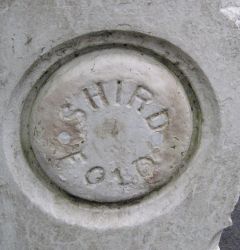
Gatepost of 71 The Crescent, 2014.
A Cheshire Farm
Shird Fold (or Shirdfold, or Sherd Fold) was a farm in Adlington, Cheshire, with a history going back many centuries as part of the estates held by the Legh family of Disley and nearby Adlington Hall. According to J.P. Earwaker in his classic work East Cheshire: Past and Present, published in 1877, it appears in a document dated 1438 as 'le Sherde.'
Thomas Legh, who died in 1691, 'was succeeded in the estates by his eldest son, John, who was then 32 of age ... During his time some important additions were made to the family estates. In the year of his he marriage purchased from William Sherd, of Sherd and Disley, the descendant of an old companion in arms of his grandfather, the estate of Sherd-fold on the confines of Adlington.'
To discover how the name appeared in Davenport we have to look at the family history of Elizabeth Shepherd, the wife of James Shepherd; it was common for the lady of the house to have the honour of choosing a name.
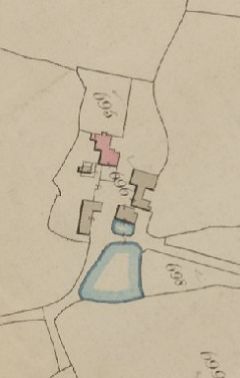
Shird Fold Farmhouse on the tithe map, circa 1850.
The tithe map records the owner as Charles Richard Banastre Legh, and the occupier as John Grantham. This John Grantham, farmer of 230 acres, was the father of Elizabeth Shepherd; the 1851 census lists him aged 55 at Shird Fold with his wife Elizabeth (59), their daughter Heziah (24), their son John [junior] (20), Mary Ann (18), Elizabeth (16), Hannah (13), Alice (11), Emma (8), and Amelia (5). Four farm workers also lived on the site: Peter Conway, Joseph Hadfield, John Snape and Stephen Mallow(?).
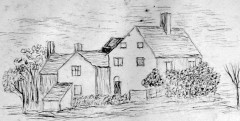
Shird Fold. Drawing by 19th-century historian John Owen.
The 1861 census for Shird Fold reveals the tragic fact that young Elizabeth had in the intervening years been married and already widowed by the age of 26, her name becoming Elizabeth Barrow under which she married James Shepherd in 1866. It would be interesting to know how a widow from a Cheshire farm met an Engineer from Manchester (shared religion perhaps), but clearly she had fond memories of her old home at Shird Fold, and her original surname of Grantham. Their first daughter was christened Catherine Grantham Shepherd. Following Catherine's marriage to Frederick Davenport Bates, their house on Mile End Lane was dubbed 'Grantham Gate' further perpetuating the family name.
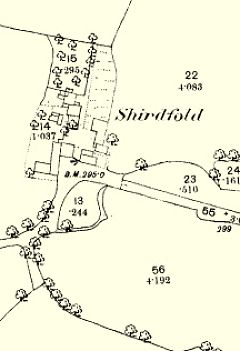
Map from 1909 The single-word variant of the name.
John Grantham died in 1866; his son John (born c. 1830) continued to farm the 250 acres of Shird Fold, but by 1878 he had moved to a smaller farm in High Lane where he died in 1892.
The next farmer of Shird Fold, which by then covered 342 acres, was George Mottram, born in Chorley, Cheshire in 1826, who previously ran the smaller Dingle Crow Farm in Fulshaw. By 1891 he had retired and was living in a small cottage in Thorniley Street, Stockport; he died in 1892.
A newspaper advert from 1888 announces an auction at Shird Fold, on behalf of a Harry Hooton (b. Sale, 1860), who was leaving the farm. On offer were a number of pedigree horses and their feed. Possibly he was renting part of the farm. He moved to Woodbank Farm, Stockport, and later to Australia where he died in 1948.
The farmer by 1891 was Eli Pennington (see note at the end of the main text). In 1898, the Manchester Guardian recorded that he was fined £5 for selling milk containing 4.2% of added water.
By 1901 he had apparently handed on the tenancy of Shird Fold to his son (also Eli Pennington), and taken on Bradshaw Hall Farm in Cheadle Hulme, which along with its associated mansion Bradshaw Hall, has been subject of one of my articles, and in 1911 he was at Old Hall Farm in Woodford.
Unfortunately Eli Pennington 'the younger' ran into financial problems, as he is included in a 1907 list of bankruptcies. By 1911 he had moved with his family to another area, working as a wood sawyer for a timber merchant in Newport, Shropshire.
In 1917, by which date the farmer at Shird Fold was a James Pollitt, the contents of the farm were sold at auction. The list of auction lots from the Manchester Guardian of 17 November gives an idea of the farm's status at that date: '33 head of dairy and fat stock, consisting of 25 in-calf cows and heiffers, five fat beasts, two-year-old bull, two rearing calved, seven horses, three useful draught horses, powerful five-year-old shire mare, draught yearling filly, driving mare, and light horse; implements, all modern and good order, including Massie Harris binder, swath turner, lurry, carts, milk floats, pair-horse mowing machine, land roller, balance ploughs, splitting boxes, &c.'
Major change came to the Shird Fold area in 1924 when the neighbouring New Hall Farm was purchased by A.V. Roe & Co. (Avro), aircraft builders, initially as location for an airstrip for the test flying of their products which had previously taken off from Alexandra Park, Manchester. In subsequent years the site (known as Woodford as the main entrance lay in that village) expanded to become a major aircraft-building site, including a tarmac runway, extensions of which required the purchase of part of Shird Fold Farm.
Many aircraft types were built there, including the famous Avro Lancaster and Vulcan bombers. Through a series of mergers, he Avro company became part of British Aerospace who closed the site in 2011, and sold it to property developers.
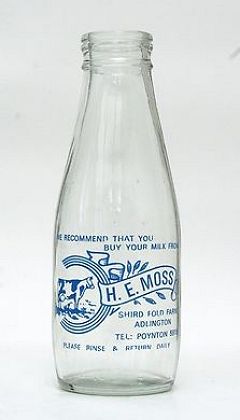
The remainder of the land continued to be farmed: farmers included James and Ralph Mountford from 1938; the Leigh family built a new farmhouse for them, but part of the original remained standing in derelict condition until finally demolished in 1969 soon after Harry Moss and his family, moved from Pepper Street Farm in Bramhall, which was sold for housing, to take over.
Shird Fold continued to operate as a dairy farm, gaining a number of additional buildings. By 2000 a herd of 250 cows was being maintained - quite a contrast from the 25 listed in the 1917 sale. The Moss family diversified, setting up a golf centre on part of the land.
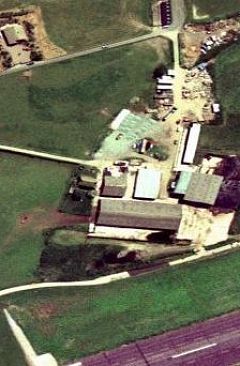
Shird Fold farm in its last days. Shird Fold cottage, top left. Woodford aerodrome runway, bottom right.
In 2001, dairy farming at Shird Fold came to a sudden and sad end when at the height of that year's epidemic of foot-and-mouth disease, symptoms were detected in the farm's cows. On the morning of 27 March 2001 all the cows were shot and their carcasses later burnt. Later reports suggested that the presence of foot-and-mouth had not been definitely established.
Farmer Moss received financial compensation, and gave up his tenancy to British Aerospace; he and his wife retired to a modern bungalow built for them nearby which took the name Shird Fold. For a while they traded as a 'Superior Bed and Breakfast.'
All the buildings on the farmyard area were demolished in 2010. The area of the Avro factory was sold to Harrow Estates and is seeing ongoing housing development, but some remaining green space will, we are told, be retained for 'agricultural uses'.
The Old Farmhouse
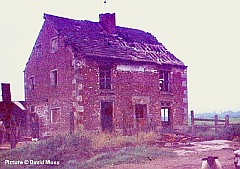
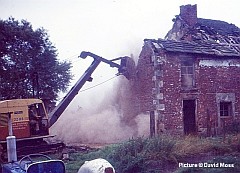
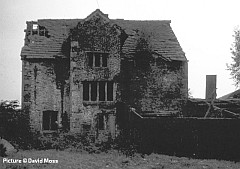
Photographed during demolition in 1969. Pictures by courtesy of David Moss.
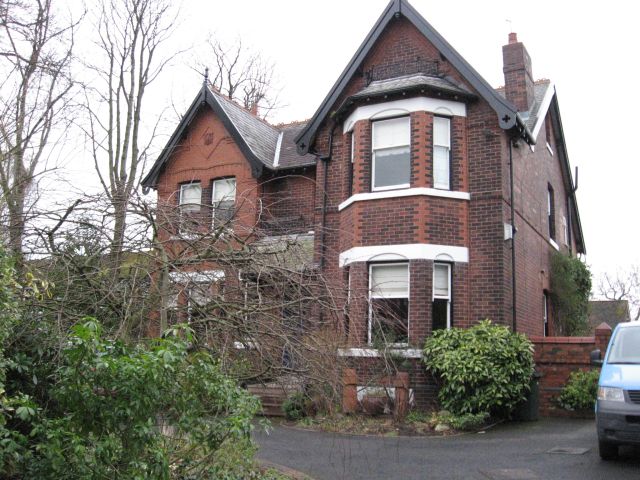
Whilst strolling the older streets in Davenport, the eye of the curious may be attracted to the names of the houses, still preserved on gateposts, or in plaques high on the wall. These were essential as well as decorative in the early days of Davenport, as the systematic numbering of houses was not always generally applied. Many of the names are of a generalised 'countryside' form (Oak House, The Alders), while others clearly derive from the early owner's favourite holiday resorts (Wylfa, Arisaig). But a few of them seem to offer a mystery for the local historian to explore. Such a one is 'Shird Fold', more prosaically known today as No. 71 The Crescent. Our picture of the house is from 2014, showing the typical 1890s design features, including the half-basement and consequential steps up the front door, the decorative brickwork, and the wrought-iron railings around the roof of the bay windows. It is included in the Egerton Road / Frewland Avenue Conservation Area in which development is now strictly controlled.

This house was built, around 1891, for James Shepherd, on land leased from John Hooley, a Stockport nurseryman. Hooley had purchased the land which now forms The Crescent (originally called Davenport Crescent) following the 1877 disposal of the estate of the Davenports of Bramhall Hall. The 1898 edition of the Ordnance Survey map shows 'Shird Fold' (marked here in red) with a number of nearby plots still undeveloped.
James Shepherd, born c.1835, was an engineer by trade - he was a mechanical engineer, but in Victorian days such a profession was not fully accepted - he described himself on early census records as a civil engineer - as distinct from a military engineer. His earliest years have proved difficult to uncover: he was born in Manchester, and would seem to be the same James Shepherd listed (age 27) in 1861 living at 16 Harding Street, Ancoats with his wife Mary (26) and and their children Thomas (age 6), Elizabeth (3) and Charles (1). He described himself as a 'Prospecting Engineer'. The family had a domestic servant, 12-year old Fanny Hughes.
Mary Shepherd must have died very young, as did so many in those years: 1866, James had married again in Manchester, and with his three children, a new wife Elizabeth (formerly Elizabeth Barrow), and James and Elizabeth's new daughter, Catherine Grantham Shepherd, aged 1. Their new home was 11 Monmouth Terrace, Rusholme, then a desirable middle-class suburb. James recorded his son Thomas as an engineering apprentice; probably he was working with his father to learn the trade.
By 1881 they were still in Rusholme, now at 2 Denbigh Villas, with daughters Elizabeth and Catherine, joined by son Lavington Watt Shepherd (8) and daughter Florence Shepherd (5). The origin of the unusual names 'Lavington Watt' is something of a mystery; it must have been significant to the family, as James's son (by his first marriage) Thomas Shepherd gave the exact same name to his youngest son, born about 1893, creating some genealogical confusion. There must be some connection with the Wiltshire village of Market Lavington, which has a street called 'Watt's Way' but we haven't been able to discern the connection.
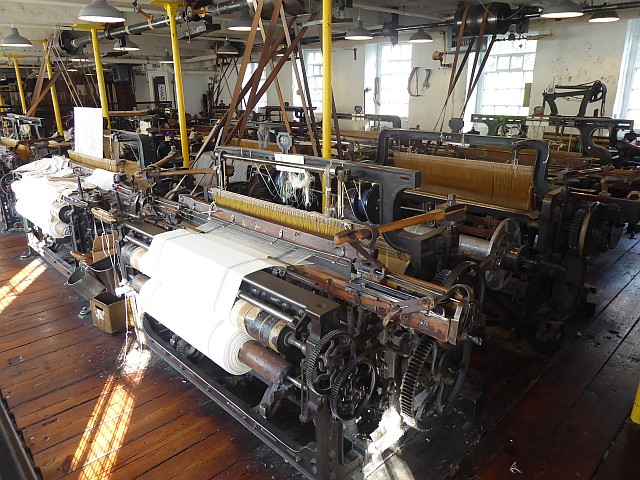
The weaving shed, Quarry Bank Mill, with overhead shafts and pulleys.
It was around this time that James, perhaps while working in one of the many factories that used line-shafts, pulley wheels and belts to drive all individual machines - looms or machine tools for example - from one large steam engine, had an Idea. It occurred to him that as the belt ran round the pulley, air was drawn in which would lead to slipping, and reduction in the amount of power transmitted. If the air had a means of escape, the problem would be reduced, so why not make holes or channels round the pulley for this to happen? A simple idea, but in February 1884 he was awarded a Patent giving him the right to bar others from manufacturing such pulleys for 20 years, and later obtained patents in other countries.
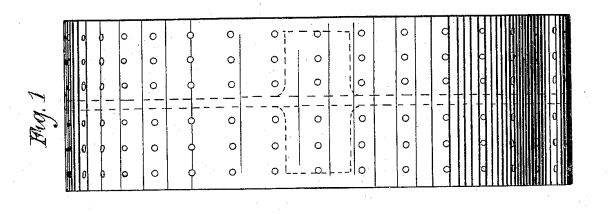
This diagram is from his US Patent application, showing perforations in the working surface of the pulley. The result was the foundation of the Patent Power Pulley Company Ltd in 1886 to manufacture the pulleys; premises were obtained in the shape of the Union Works in Carpenter Street (Off Charles Street), Manchester.
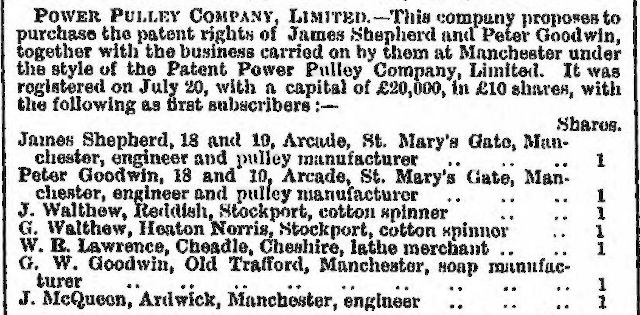
Among the first Shareholders in the company when it 'went public' in 1886 and dropped the 'Patent' from its name included John and George Walthew, cotton spinners and leading citizens of Stockport.
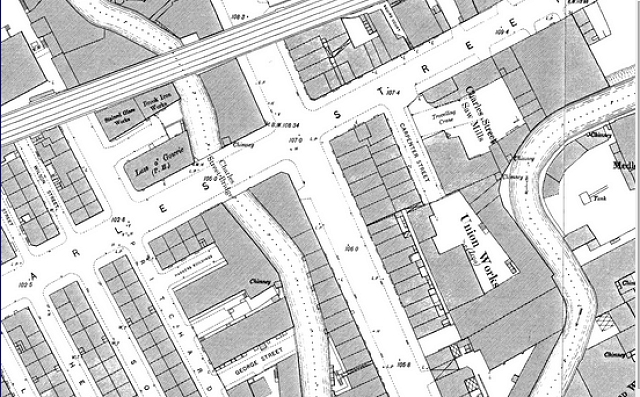
This map from the period shows the Union Works in relation to the River Medlock and the railway viaduct between Manchester Oxford Road and Piccadilly stations. In 2014 the area is much altered: the only building remaining unaltered is the Lass O'Gowrie public house; some of the river has been covered over, Carpenter Street has vanished, and the approximate site of the Union Works is the car park adjacent to Princess Street behind the Ibis Hotel.
By 1891, James had moved his family to the leafy suburb of Davenport. The 1891 census shows James, Elizabeth, Catherine, Lavington, Florence and servant Olive Wootton at 'Holly House', a now-lost house on Bramhall Lane which we guess they were renting during the construction of their new permanent home on The Crescent. Catherine Grantham Shepherd married artist Frederick Davenport Bates: their story continues in another feature.
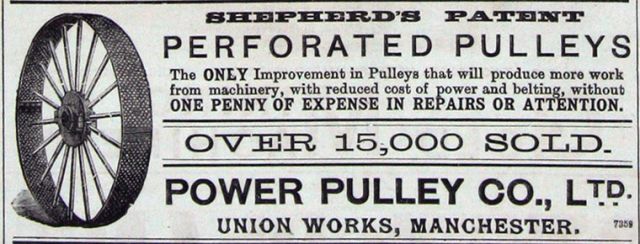
An advertisement from the trade press in the Edwardian period shows that the company flourished for many years. Over time, it diversified into other pulley-related products such as a steel belt which could replace the traditional leather version. Lavington Watt Shepherd joined his father in the firm; by 1901 the household at Shird Fold comprised James (67) and his wife Elizabeth, James's daughter by his first marriage Elizabeth Connelly and her daughter Catherine (8), Lavington and servant Annie Hulse.
In the 1890s, local artist Frederick Bates was planning a painting trip to the Holy Land, and seeking finance from the businessmen of the Davenport area, which would be repaid from the money to be raised by charging admission to displays of the resulting large religious works. However the consortium made little profit, but from the contacts he had made, Bates gained a wife. In 1899 he marries Catherine Grantham Shepherd.
By 1911, more major changes had occurred in the family. James had died in 1905, and Lavington, who took over as Managing Director, had married and moved into his own house, 'Saxonholme' in nearby Davenport Park. Elizabeth must have decided that a smaller house was in order, and she moved with the remaining family into a semi-detached house, No. 22 The Crescent, across the road, which she appears to have again named 'Shird Fold', although the gatepost of the original large house retains the name up to the present day.
Elizabeth Shepherd died on 11 May 1919 at 22 The Crescent, aged 84, and is buried at Dean Row Unitarian Chapel near Wilmslow.
In the 1920s Lavington Watt Shepherd was awarded two patents for improvements to the company products, but the period would have seen the demand for the company's products decline, due to the economic depression and also the move away from centralised power in factories to individual electric motors on machines. In 1931 the Power Pulley Company entered voluntary liquidation, the Chairman, Lavington Watt Shepherd, then of 'Charlton', Manor Road, Cheadle Hulme was appointed as 'Liquidator for the purposes of winding-up.' A new company, Power Pulley Company (1931) Ltd., was formed, but whether it continued in manufacturing we have been unable to discover, although by the 1950s the Union Works was occupied by the Stedall Machine Tool Company.
After the Shepherds
The large house, now referred to simply as 27 The Crescent, was sold to Gerald Darrah, lead manufacturer, aged just 30 in 1911, who moved there from Heaton Chapel with his wife Annie and children Kenneth, Edna and Eileen Ruth. Their income stretched to two live-in 'general servants', Elizabeth Howard and Elsie Gilman. The 1911 census asked the number of rooms in the house, not including lobby, closet or bathroom: the answer was ten. Gerald had taken over the family firm from his father Charles Darrah; he had married Annie Willis in 1904. They renamed the house 'Tal y Llyn' after the famous Welsh beauty spot. By 1924 he was at 'Foxenholme' on Bramhall Lane, Davenport, and later years found him at 'Ferndown', Ladythorn Crescent, Bramhall, and finally 11 Carrwood Road, Bramhall. He died, aged 80, in 1961.
The householder in 1924 was Robert Stott, who kept the house name Tal y Llyn, according to telephone directories, although somehow the 'Shird Fold' gatepost survived. The house number was changed from 27 to 71 in a major renumbering scheme in the 1940s when the large house 'The Paddocks' (formerly 'The Alders' - see separate feature) was demolished, and 29 new homes built on its grounds, 18 of which required numbers on The Crescent.
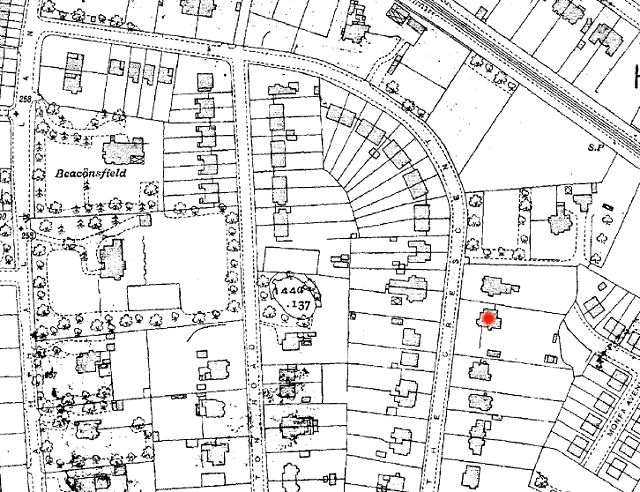
The map above shows 71 The Crescent as it was in 1934, showing the building which had taken place in what were once open fields to the rear. In more recent times, its garden had seen 'infill' building developments in the form of 71a The Crescent to the south of the house, and two detached houses on the eastern part of the garden, which are accessed from Edmonton Road to the rear. But in 2020, as our heading picture shows, 'Shird Fold' still stands, having survived the fate of no. 69 'Cresgarth' to the north which has been totally replaced by 12 units of 'age exclusive housing' known as 'Cresgarth House.'
Eli Pennington: A personal note
While researching the history of Shird Fold Farm, I noticed that that the farmer in the 1890s was Eli Pennington (senior), born in Kettleshulme in 1852. The name seemed familiar.
The Cheshire village of Kettleshulme is the ancestral home of the Hill family, including George Hill, whose grand-daughter Agnes Hill was the mother of the author of this article. George Hill's brother Thomas Hill married Eliza Pennington, sister of Eli Pennington. I tell something of the lives of these families in an article on my Family History site.
Eli Pennington (senior) appears to have prospered enough by 1919 to purchase a farm of his own, Dairy Ground Farm on the edge of the village of Bramhall, which had been part of the estate of the Davenports of Bramall Hall. The farm has remained in the Pennington family to the present day, since 1960 operating as Pennington's Stables and offering family-friendly equestrian facilities.
I have passed the stables frequently while cycling, blissfully unaware of the family connection until the preparation of this feature.
Postscript: Shird in the Seventeenth Century
Recent research by Sue Bailey has brought to light the will of one Margaret Dale, spinster of Bramhall, dated 1647. Baptised, probably, in 1579, she was related to William Siddall of Siddall Houses in Bramhall who was her cousin, but more interestingly, her sister Marie Dale (b. 1595 in Prestbury) was married Robert Reddiche of ‘Shert’ in Adlington. They had three sons and two daughters, all named in the will. It seems likely that, going back a generation, Robert Reddiche’s father was William Reddiche (b. 1576, Adlington).
'I give and bequeathe unto my sister Marie Reddiche wife of the before named Robert Reddiche the summe of five poundes and to Dorothy Reddich and Bridget Reddich her daughters the sum of fortie shillings a peece, and to Margaret Reddiche my godchild I give and bequeathe three pounds. Item I give and bequeathe unto John Reddiche, William Reddiche and Robert Reddiche, sonnes of the before named Marie Reddiche to evrie one of them twentie shillings apeece.'
Related features
This feature interlinks and overlaps with several others on this site, especially:
Jessie Lumb and the Crescent
The Alders and its Account Book
Frederick Davenport Bates
A postcard from Oberhofen
Sources and thanks
Many sources have been used for this feature, including Ancestry.co.uk, Grace's Guide, Cheshire Tithe Maps, Cheshire Directories, the British Newspaper Archive, and the Land Registry.Special thanks are due to Gary Simpson for information on his ancestor George Mottram, David Moss for family infomation and the images of Shird Fold, and Sue Bailey, author of the book History of Woodsmoor.
Author's note: any history of this kind must, if it is ever to see the light of day, be incomplete, and contain some errors and speculation, and this one is certainly no exception. I'd be very pleased to hear from anyone with comments, additions or corrections. - Charlie Hulme
Written by Charlie Hulme, 2015. Updated January 2020.
Comments welcome at info@davenportstation.org.uk